YAMAHA XJ6F 2016 Repair Manual
Manufacturer: YAMAHA, Model Year: 2016, Model line: XJ6F, Model: YAMAHA XJ6F 2016Pages: 104, PDF Size: 2.88 MB
Page 61 of 104
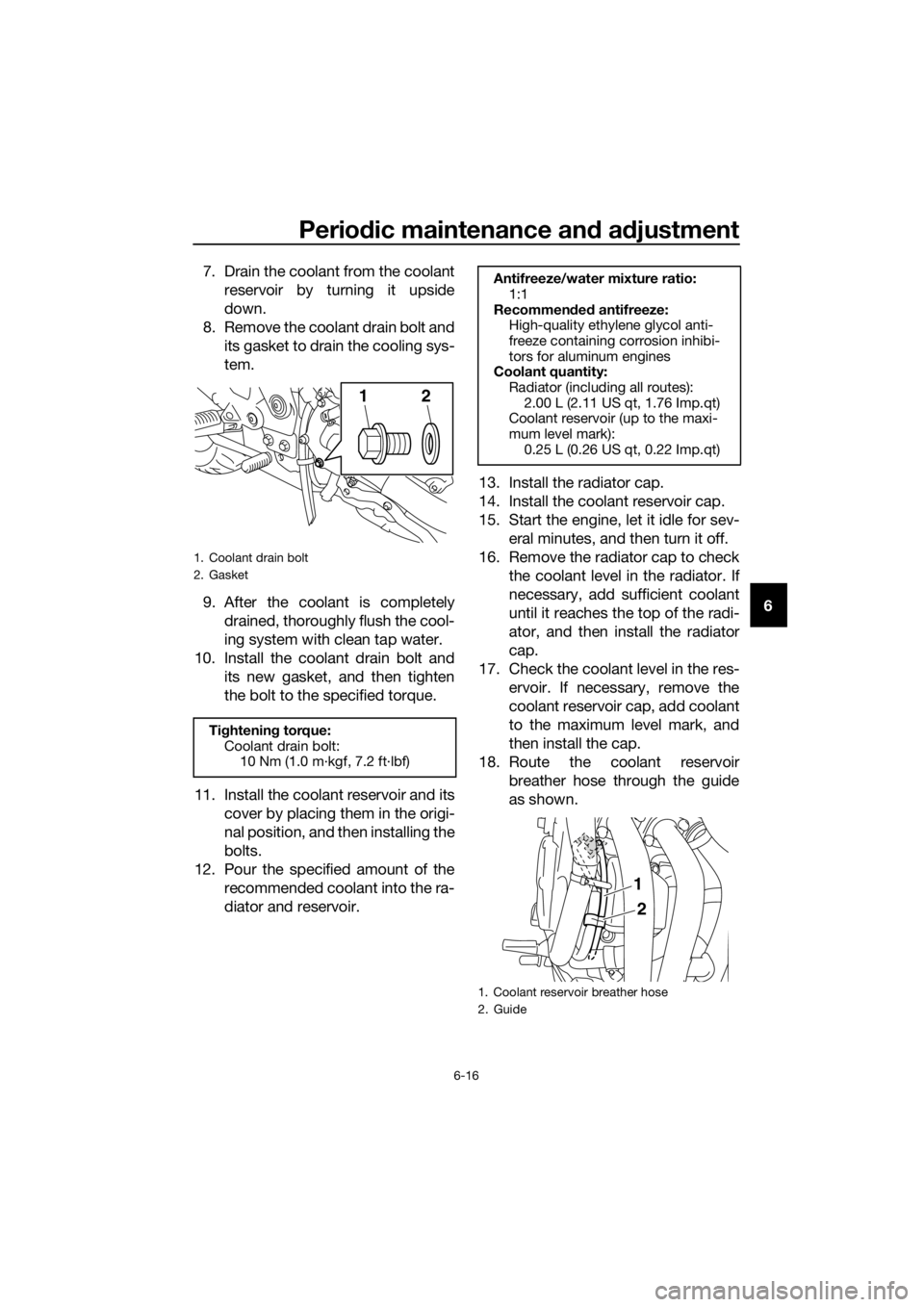
Periodic maintenance an d a djustment
6-16
6
7. Drain the coolant from the coolant
reservoir by turning it upside
down.
8. Remove the coolant drain bolt and its gasket to drain the cooling sys-
tem.
9. After the coolant is completely drained, thoroughly flush the cool-
ing system with clean tap water.
10. Install the coolant drain bolt and its new gasket, and then tighten
the bolt to the specified torque.
11. Install the coolant reservoir and its cover by placing them in the origi-
nal position, and then installing the
bolts.
12. Pour the specified amount of the recommended coolant into the ra-
diator and reservoir. 13. Install the radiator cap.
14. Install the coolant reservoir cap.
15. Start the engine, let it idle for sev-
eral minutes, and then turn it off.
16. Remove the radiator cap to check the coolant level in the radiator. If
necessary, add sufficient coolant
until it reaches the top of the radi-
ator, and then install the radiator
cap.
17. Check the coolant level in the res- ervoir. If necessary, remove the
coolant reservoir cap, add coolant
to the maximum level mark, and
then install the cap.
18. Route the coolant reservoir breather hose through the guide
as shown.
1. Coolant drain bolt
2. Gasket
Tightening torque:
Coolant drain bolt: 10 Nm (1.0 m·kgf, 7.2 ft·lbf)
21
Antifreeze/water mixture ratio:
1:1
Recommen ded antifreeze:
High-quality ethylene glycol anti-
freeze containing corrosion inhibi-
tors for aluminum engines
Coolant quantity:
Radiator (including all routes): 2.00 L (2.11 US qt, 1.76 Imp.qt)
Coolant reservoir (up to the maxi-
mum level mark): 0.25 L (0.26 US qt, 0.22 Imp.qt)
1. Coolant reservoir breather hose
2. Guide
2
1
UBS1E0E0.book Page 16 Thursday, October 8, 2015 3:40 PM
Page 62 of 104
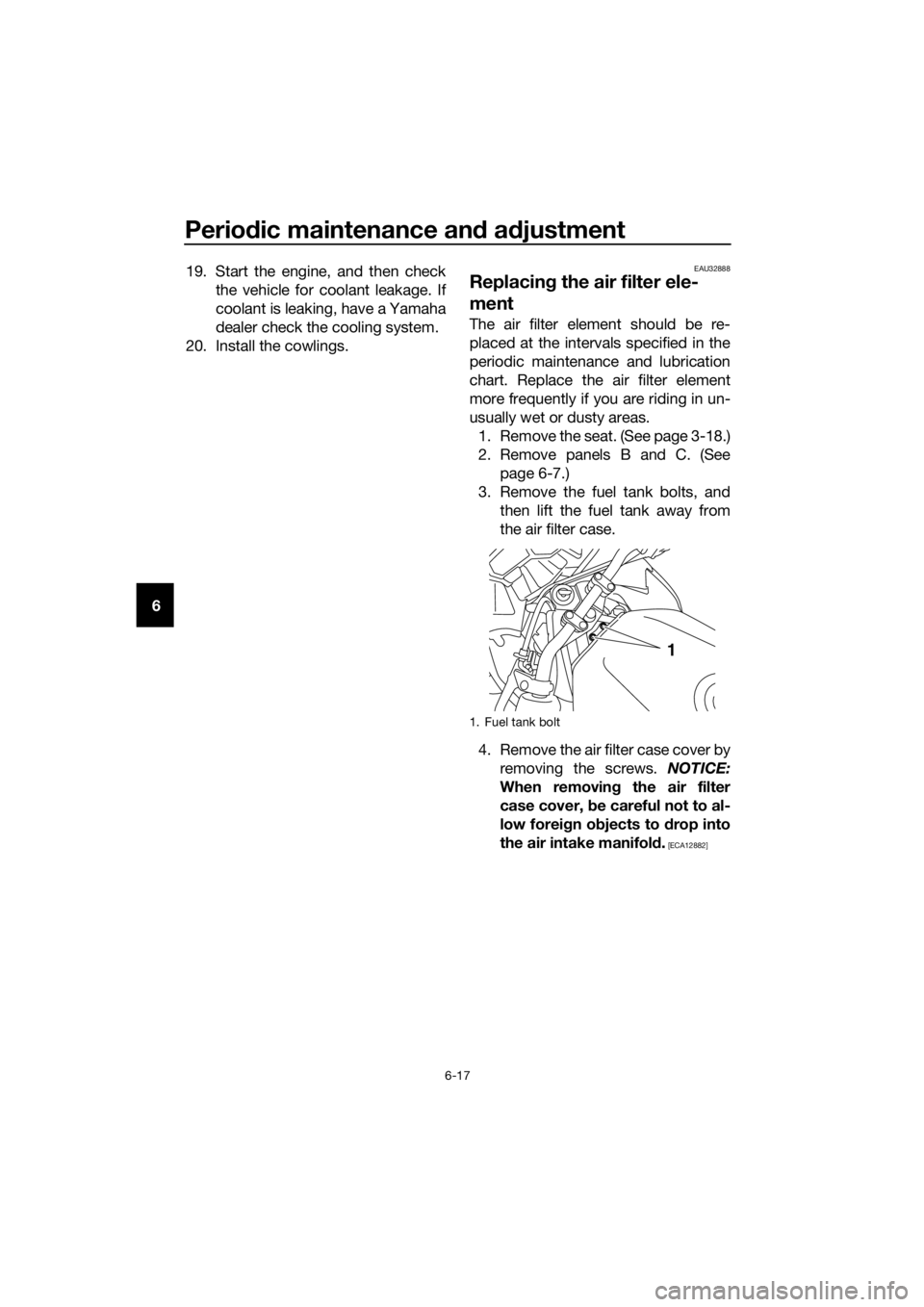
Periodic maintenance an d a djustment
6-17
6 19. Start the engine, and then check
the vehicle for coolant leakage. If
coolant is leaking, have a Yamaha
dealer check the cooling system.
20. Install the cowlings.
EAU32888
Replacin g the air filter ele-
ment
The air filter element should be re-
placed at the intervals specified in the
periodic maintenance and lubrication
chart. Replace the air filter element
more frequently if you are riding in un-
usually wet or dusty areas.
1. Remove the seat. (See page 3-18.)
2. Remove panels B and C. (See page 6-7.)
3. Remove the fuel tank bolts, and then lift the fuel tank away from
the air filter case.
4. Remove the air filter case cover by removing the screws. NOTICE:
When removin g the air filter
case cover, b e careful not to al-
low forei gn o bjects to d rop into
the air intake manifol d.
[ECA12882]
1. Fuel tank bolt
1
UBS1E0E0.book Page 17 Thursday, October 8, 2015 3:40 PM
Page 63 of 104
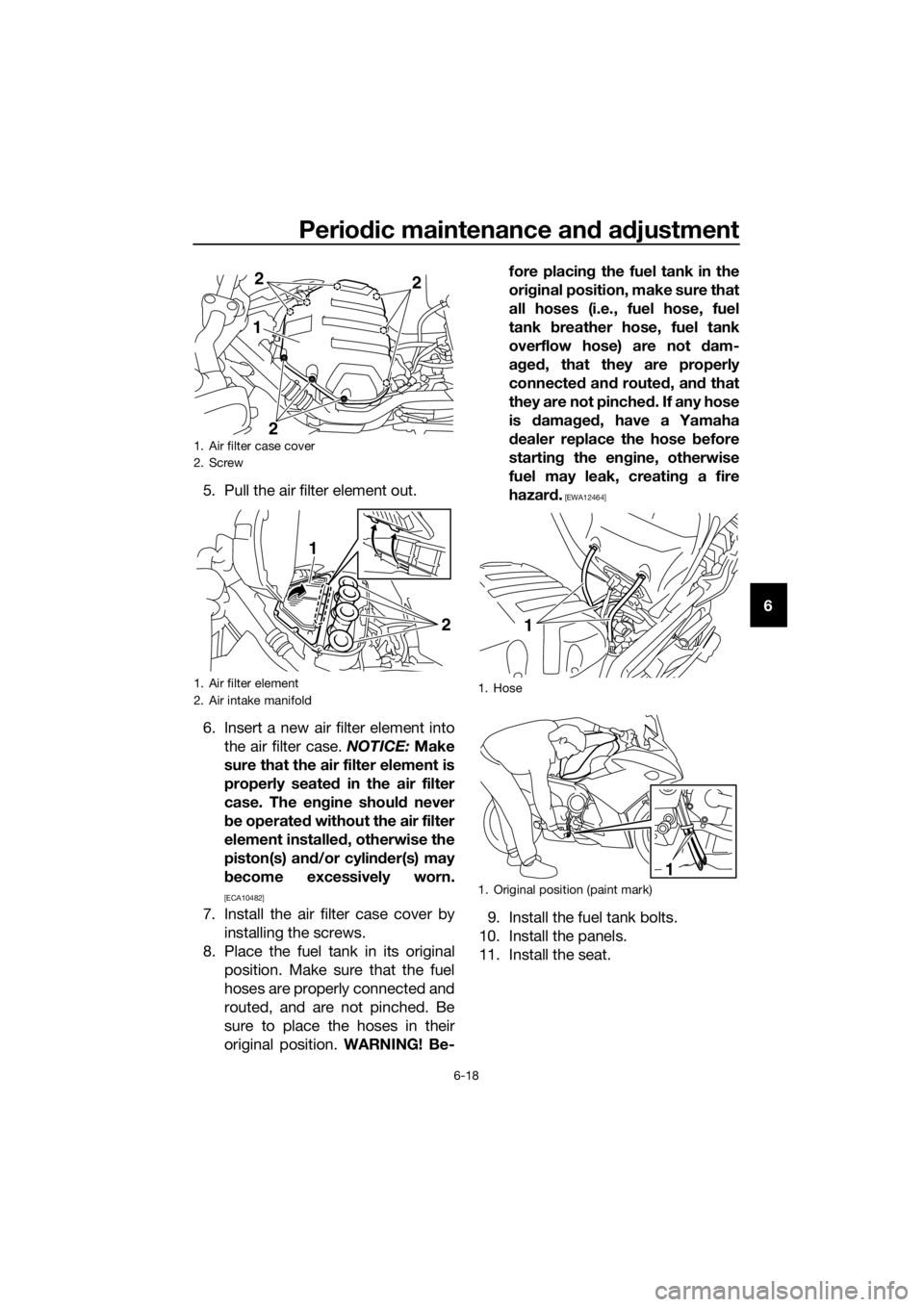
Periodic maintenance an d a djustment
6-18
6
5. Pull the air filter element out.
6. Insert a new air filter element into
the air filter case. NOTICE: Make
sure that the air filter element is
properly seated in the air filter
case. The en gine shoul d never
b e operated without the air filter
element installed , otherwise the
piston(s) an d/or cylin der(s) may
b ecome excessively worn.
[ECA10482]
7. Install the air filter case cover by
installing the screws.
8. Place the fuel tank in its original position. Make sure that the fuel
hoses are properly connected and
routed, and are not pinched. Be
sure to place the hoses in their
original position. WARNING! Be- fore placin
g the fuel tank in the
ori ginal position, make sure that
all hoses (i.e., fuel hose, fuel
tank breather hose, fuel tank
overflow hose) are not dam-
a g ed , that they are properly
connected and route d, an d that
they are not pinche d. If any hose
is damag ed , have a Yamaha
d ealer replace the hose before
startin g the en gine, otherwise
fuel may leak, creatin g a fire
hazar d.
[EWA12464]
9. Install the fuel tank bolts.
10. Install the panels.
11. Install the seat.
1. Air filter case cover
2. Screw
1. Air filter element
2. Air intake manifold
1 2
2
2
2
1
1. Hose
1. Original position (paint mark)
1
1
UBS1E0E0.book Page 18 Thursday, October 8, 2015 3:40 PM
Page 64 of 104
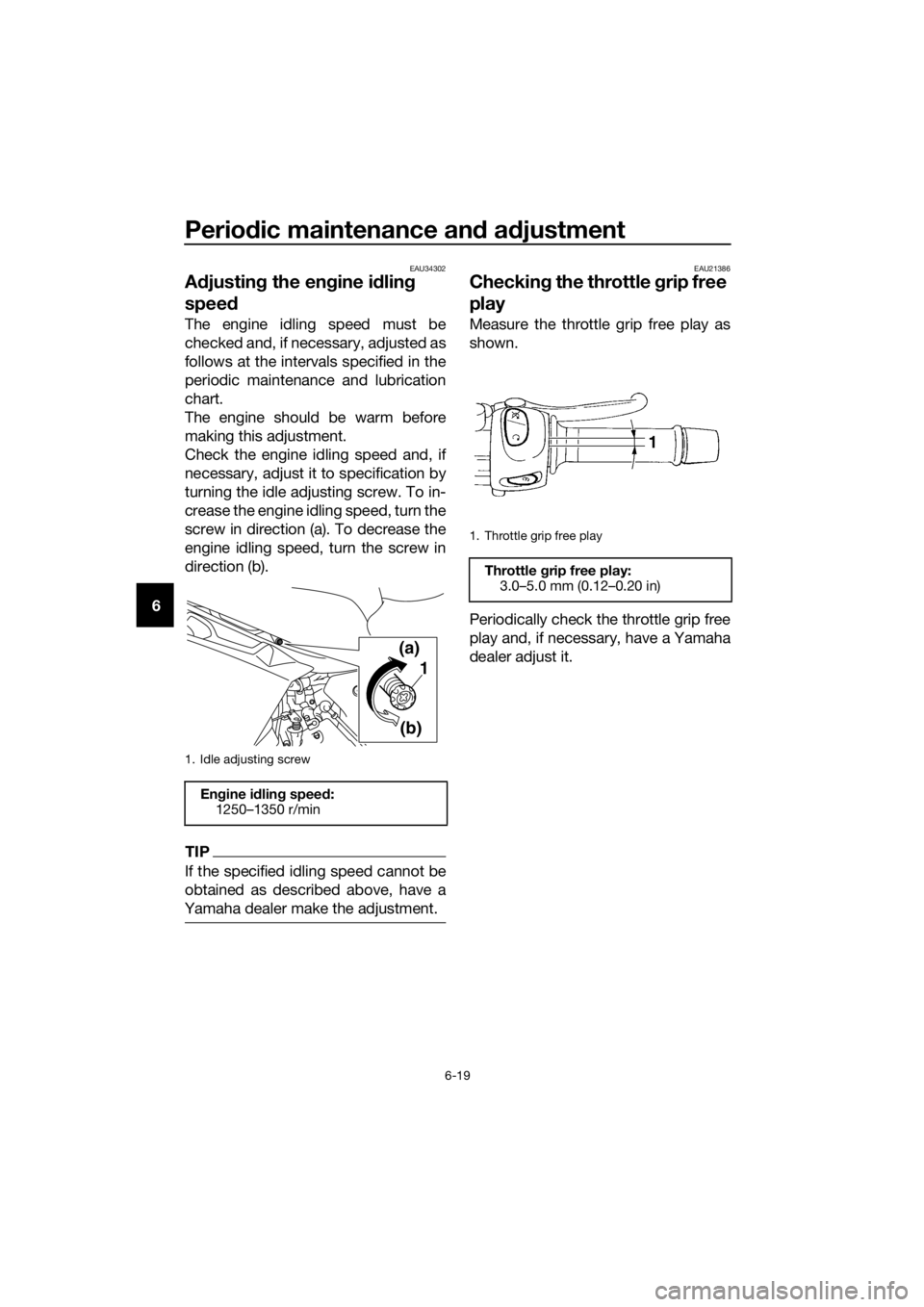
Periodic maintenance an d a djustment
6-19
6
EAU34302
A djustin g the en gine i dlin g
spee d
The engine idling speed must be
checked and, if necessary, adjusted as
follows at the intervals specified in the
periodic maintenance and lubrication
chart.
The engine should be warm before
making this adjustment.
Check the engine idling speed and, if
necessary, adjust it to specification by
turning the idle adjusting screw. To in-
crease the engine idling speed, turn the
screw in direction (a). To decrease the
engine idling speed, turn the screw in
direction (b).
TIP
If the specified idling speed cannot be
obtained as described above, have a
Yamaha dealer make the adjustment.
EAU21386
Checkin g the throttle grip free
play
Measure the throttle grip free play as
shown.
Periodically check the throttle grip free
play and, if necessary, have a Yamaha
dealer adjust it.
1. Idle adjusting screw
En gine i dlin g spee d:
1250–1350 r/min
1
(a)
(b)
1. Throttle grip free play
Throttle g rip free play:
3.0–5.0 mm (0.12–0.20 in)
UBS1E0E0.book Page 19 Thursday, October 8, 2015 3:40 PM
Page 65 of 104
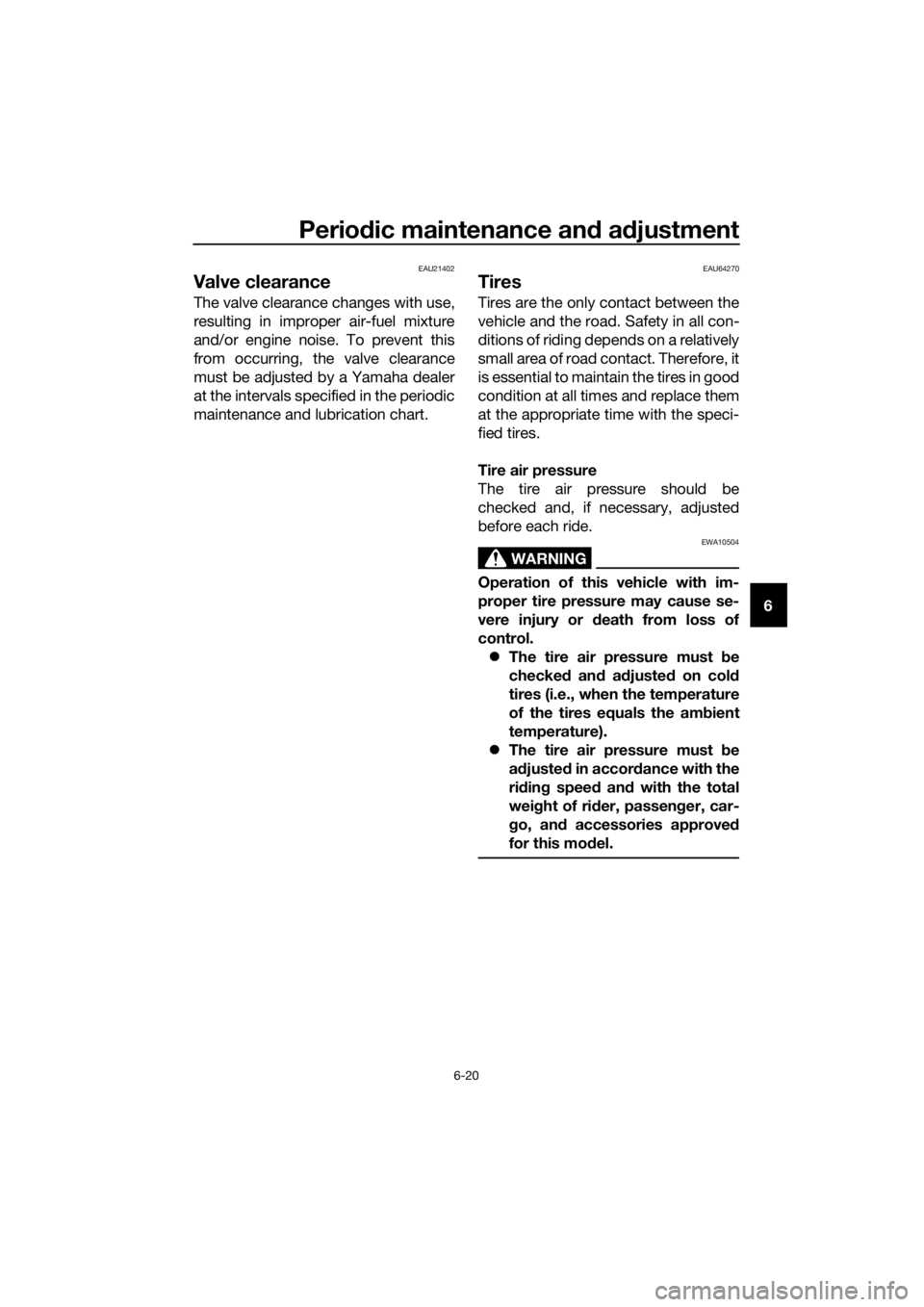
Periodic maintenance an d a djustment
6-20
6
EAU21402
Valve clearance
The valve clearance changes with use,
resulting in improper air-fuel mixture
and/or engine noise. To prevent this
from occurring, the valve clearance
must be adjusted by a Yamaha dealer
at the intervals specified in the periodic
maintenance and lubrication chart.
EAU64270
Tires
Tires are the only contact between the
vehicle and the road. Safety in all con-
ditions of riding depends on a relatively
small area of road contact. Therefore, it
is essential to maintain the tires in good
condition at all times and replace them
at the appropriate time with the speci-
fied tires.
Tire air pressure
The tire air pressure should be
checked and, if necessary, adjusted
before each ride.
WARNING
EWA10504
Operation of this vehicle with im-
proper tire pressure may cause se-
vere injury or d eath from loss of
control. The tire air pressure must b e
checked and a djuste d on col d
tires (i.e., when the temperature
of the tires equals the am bient
temperature).
The tire air pressure must b e
a d juste d in accor dance with the
ri din g speed and with the total
wei ght of ri der, passen ger, car-
g o, an d accessories approve d
for this mo del.
UBS1E0E0.book Page 20 Thursday, October 8, 2015 3:40 PM
Page 66 of 104
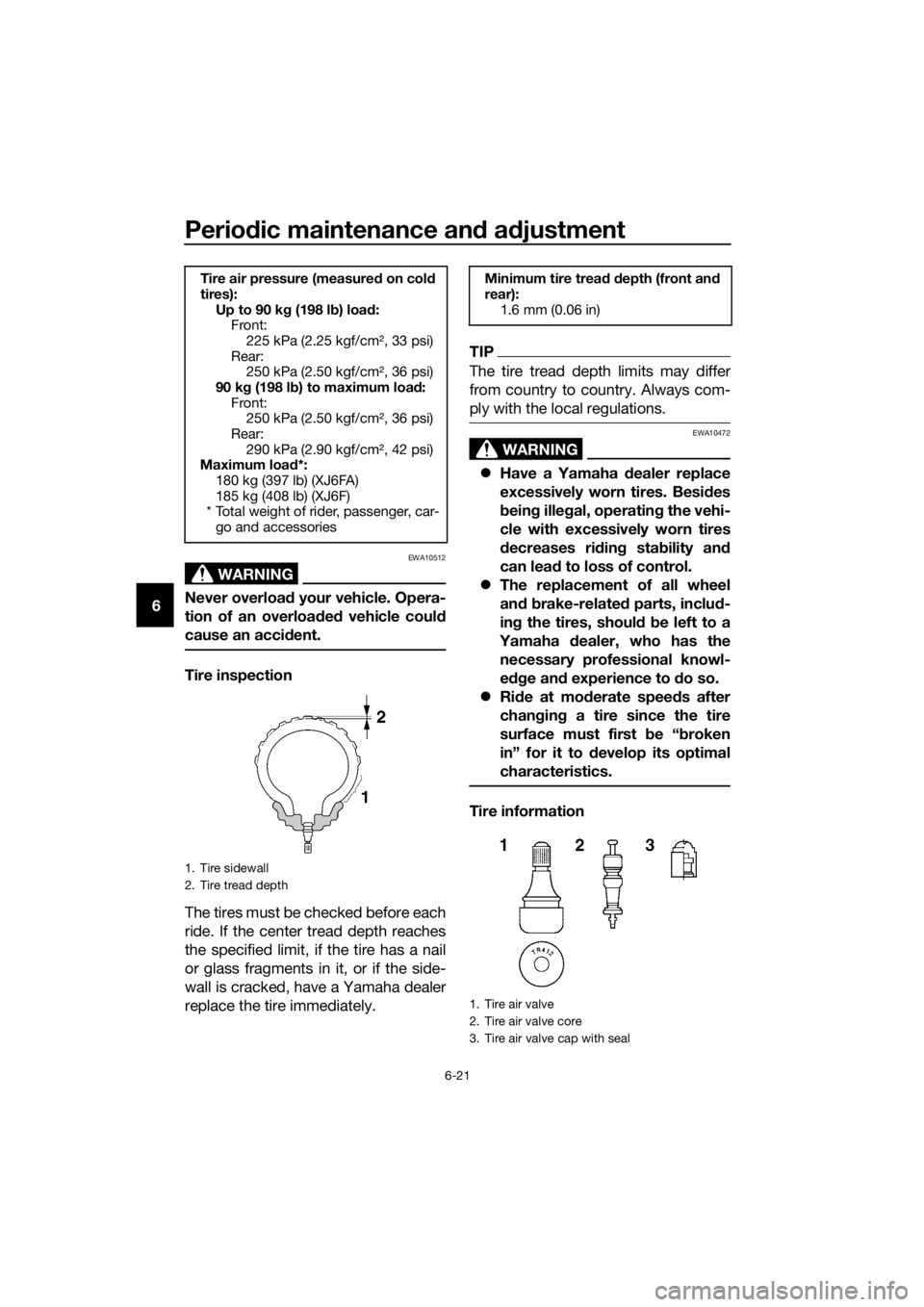
Periodic maintenance an d a djustment
6-21
6
WARNING
EWA10512
Never overloa d your vehicle. Opera-
tion of an overloa ded vehicle coul d
cause an acci dent.
Tire inspection
The tires must be checked before each
ride. If the center tread depth reaches
the specified limit, if the tire has a nail
or glass fragments in it, or if the side-
wall is cracked, have a Yamaha dealer
replace the tire immediately.
TIP
The tire tread depth limits may differ
from country to country. Always com-
ply with the local regulations.
WARNING
EWA10472
Have a Yamaha dealer replace
excessively worn tires. Besi des
b ein g ille gal, operatin g the vehi-
cle with excessively worn tires
d ecreases ri din g sta bility an d
can lead to loss of control.
The replacement of all wheel
and b rake-related parts, includ-
in g the tires, shoul d b e left to a
Yamaha dealer, who has the
necessary professional knowl-
e dge an d experience to do so.
Ride at mo derate spee ds after
chan gin g a tire since the tire
surface must first b e “broken
in” for it to develop its optimal
characteristics.
Tire information
Tire air pressure (measure d on col d
tires): Up to 90 k g (198 l b) loa d:
Front:
225 kPa (2.25 kgf/cm², 33 psi)
Rear: 250 kPa (2.50 kgf/cm², 36 psi)
90 k g (198 l b) to maximum loa d:
Front: 250 kPa (2.50 kgf/cm², 36 psi)
Rear: 290 kPa (2.90 kgf/cm², 42 psi)
Maximum load *:
180 kg (397 lb) (XJ6FA)
185 kg (408 lb) (XJ6F)
* Total weight of rider, passenger, car-
go and accessories
1. Tire sidewall
2. Tire tread depth
Minimum tire trea d d epth (front an d
rear): 1.6 mm (0.06 in)
1. Tire air valve
2. Tire air valve core
3. Tire air valve cap with seal
UBS1E0E0.book Page 21 Thursday, October 8, 2015 3:40 PM
Page 67 of 104
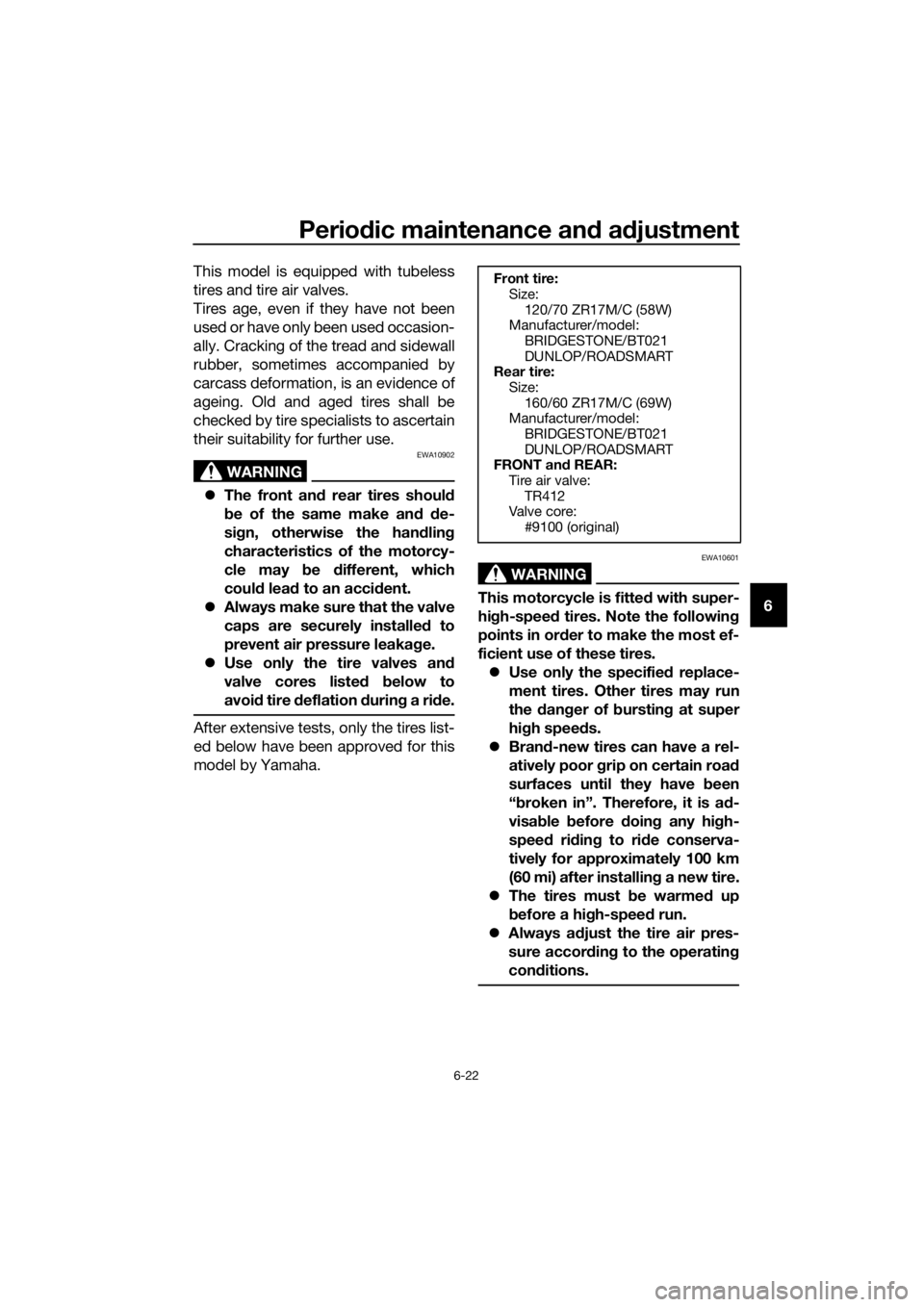
Periodic maintenance an d a djustment
6-22
6
This model is equipped with tubeless
tires and tire air valves.
Tires age, even if they have not been
used or have only been used occasion-
ally. Cracking of the tread and sidewall
rubber, sometimes accompanied by
carcass deformation, is an evidence of
ageing. Old and aged tires shall be
checked by tire specialists to ascertain
their suitability for further use.
WARNING
EWA10902
The front an d rear tires shoul d
b e of the same make an d d e-
si gn, otherwise the han dlin g
characteristics of the motorcy-
cle may b e different, which
coul d lea d to an acci dent.
Always make sure that the valve
caps are securely installe d to
prevent air pressure leakag e.
Use only the tire valves an d
valve cores liste d below to
avoi d tire deflation during a ride.
After extensive tests, only the tires list-
ed below have been approved for this
model by Yamaha.
WARNING
EWA10601
This motorcycle is fitte d with super-
hi gh-spee d tires. Note the followin g
points in or der to make the most ef-
ficient use of these tires. Use only the specifie d replace-
ment tires. Other tires may run
the dan ger of bursting at super
hi gh spee ds.
Bran d-new tires can have a rel-
atively poor g rip on certain road
surfaces until they have been
“ b roken in”. Therefore, it is a d-
visa ble before doin g any hi gh-
speed ridin g to ri de conserva-
tively for approximately 100 km
(60 mi) after installin g a new tire.
The tires must b e warmed up
b efore a hi gh-spee d run.
Always a djust the tire air pres-
sure accor din g to the operating
con ditions.
Front tire:
Size: 120/70 ZR17M/C (58W)
Manufacturer/model:
BRIDGESTONE/BT021
DUNLOP/ROADSMART
Rear tire:
Size: 160/60 ZR17M/C (69W)
Manufacturer/model:
BRIDGESTONE/BT021
DUNLOP/ROADSMART
FRONT and REAR:
Tire air valve: TR412
Valve core:
#9100 (original)
UBS1E0E0.book Page 22 Thursday, October 8, 2015 3:40 PM
Page 68 of 104
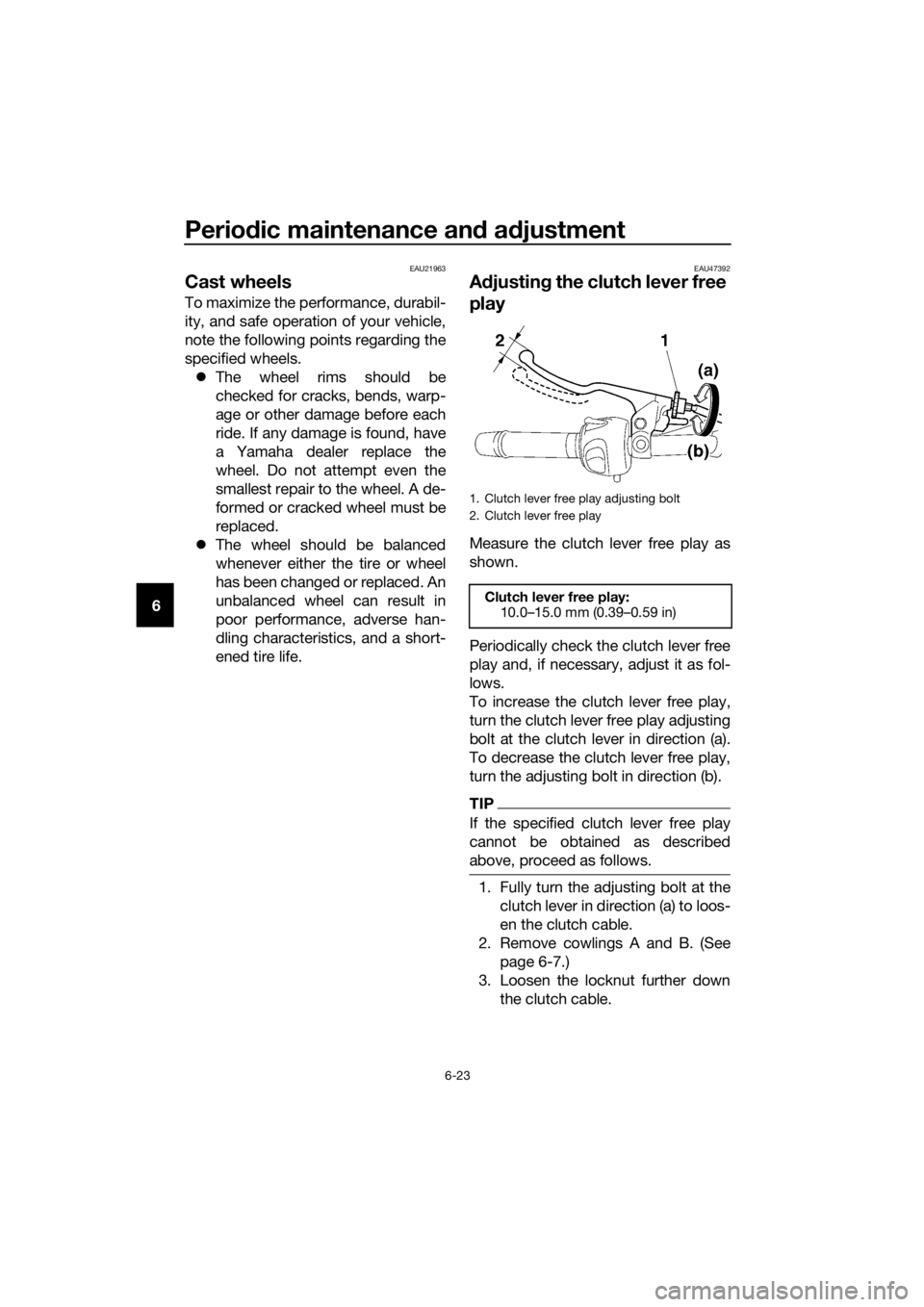
Periodic maintenance an d a djustment
6-23
6
EAU21963
Cast wheels
To maximize the performance, durabil-
ity, and safe operation of your vehicle,
note the following points regarding the
specified wheels.
The wheel rims should be
checked for cracks, bends, warp-
age or other damage before each
ride. If any damage is found, have
a Yamaha dealer replace the
wheel. Do not attempt even the
smallest repair to the wheel. A de-
formed or cracked wheel must be
replaced.
The wheel should be balanced
whenever either the tire or wheel
has been changed or replaced. An
unbalanced wheel can result in
poor performance, adverse han-
dling characteristics, and a short-
ened tire life.
EAU47392
Adjustin g the clutch lever free
play
Measure the clutch lever free play as
shown.
Periodically check the clutch lever free
play and, if necessary, adjust it as fol-
lows.
To increase the clutch lever free play,
turn the clutch lever free play adjusting
bolt at the clutch lever in direction (a).
To decrease the clutch lever free play,
turn the adjusting bolt in direction (b).
TIP
If the specified clutch lever free play
cannot be obtained as described
above, proceed as follows.
1. Fully turn the adjusting bolt at the
clutch lever in direction (a) to loos-
en the clutch cable.
2. Remove cowlings A and B. (See page 6-7.)
3. Loosen the locknut further down the clutch cable.
1. Clutch lever free play adjusting bolt
2. Clutch lever free play
Clutch lever free play:10.0–15.0 mm (0.39–0.59 in)
UBS1E0E0.book Page 23 Thursday, October 8, 2015 3:40 PM
Page 69 of 104
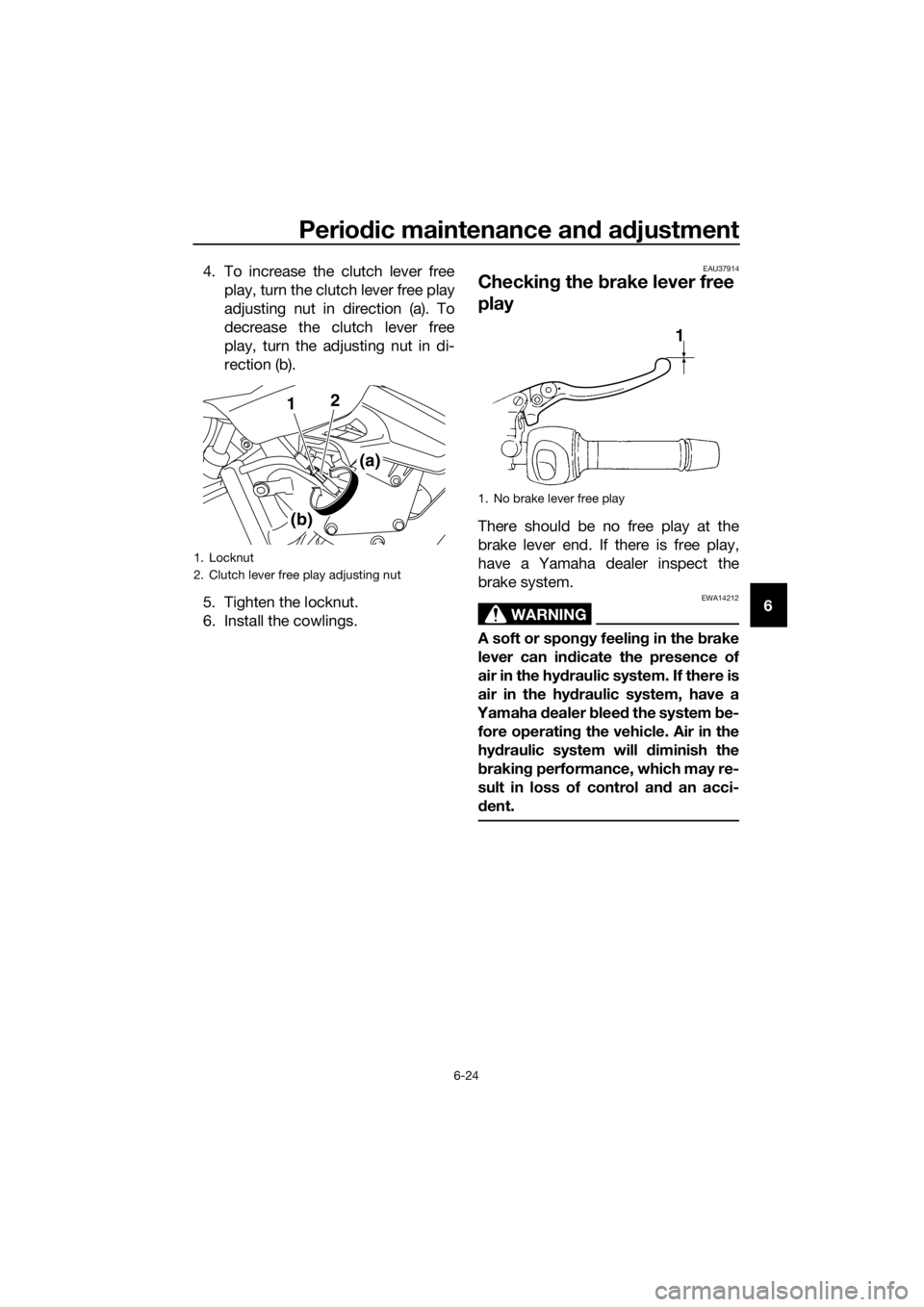
Periodic maintenance an d a djustment
6-24
6
4. To increase the clutch lever free
play, turn the clutch lever free play
adjusting nut in direction (a). To
decrease the clutch lever free
play, turn the adjusting nut in di-
rection (b).
5. Tighten the locknut.
6. Install the cowlings.
EAU37914
Checkin g the brake lever free
play
There should be no free play at the
brake lever end. If there is free play,
have a Yamaha dealer inspect the
brake system.
WARNING
EWA14212
A soft or spon gy feelin g in the brake
lever can in dicate the presence of
air in the hy draulic system. If there is
air in the hy draulic system, have a
Yamaha dealer blee d the system b e-
fore operatin g the vehicle. Air in the
hy draulic system will diminish the
b rakin g performance, which may re-
sult in loss of control an d an acci-
d ent.
1. Locknut
2. Clutch lever free play adjusting nut
1 2
(a)
(b)
1. No brake lever free play
1
UBS1E0E0.book Page 24 Thursday, October 8, 2015 3:40 PM
Page 70 of 104
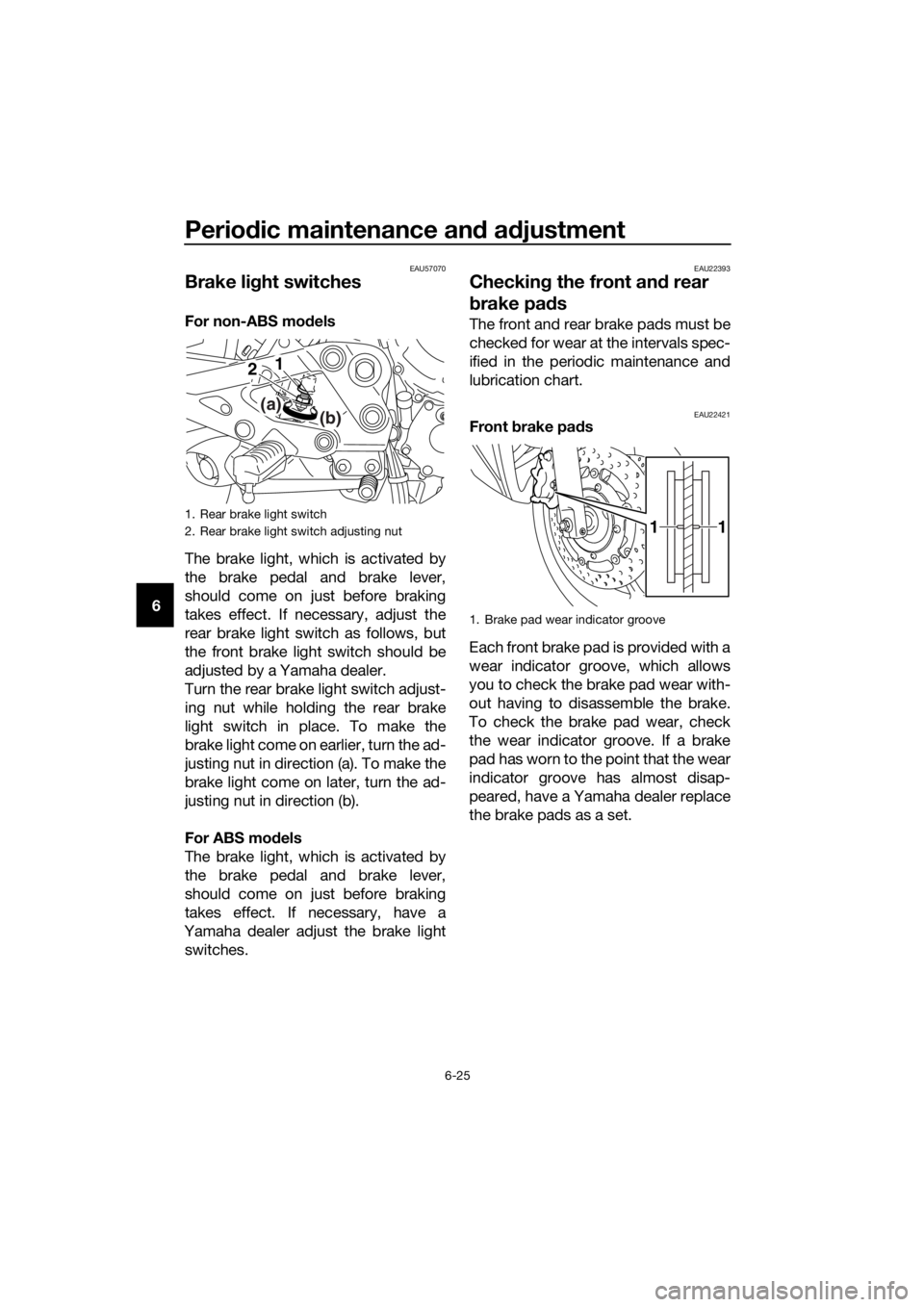
Periodic maintenance an d a djustment
6-25
6
EAU57070
Brake li ght switches
For non-ABS mo dels
The brake light, which is activated by
the brake pedal and brake lever,
should come on just before braking
takes effect. If necessary, adjust the
rear brake light switch as follows, but
the front brake light switch should be
adjusted by a Yamaha dealer.
Turn the rear brake light switch adjust-
ing nut while holding the rear brake
light switch in place. To make the
brake light come on earlier, turn the ad-
justing nut in direction (a). To make the
brake light come on later, turn the ad-
justing nut in direction (b).
For ABS mo dels
The brake light, which is activated by
the brake pedal and brake lever,
should come on just before braking
takes effect. If necessary, have a
Yamaha dealer adjust the brake light switches.
EAU22393
Checkin g the front an d rear
b rake pa ds
The front and rear brake pads must be
checked for wear at the intervals spec-
ified in the periodic maintenance and
lubrication chart.
EAU22421Front brake pa ds
Each front brake pad is provided with a
wear indicator groove, which allows
you to check the brake pad wear with-
out having to disassemble the brake.
To check the brake pad wear, check
the wear indicator groove. If a brake
pad has worn to the point that the wear
indicator groove has almost disap-
peared, have a Yamaha dealer replace
the brake pads as a set.
1. Rear brake light switch
2. Rear brake light switch adjusting nut
1
2
(a)
(b)
1. Brake pad wear indicator groove
11
UBS1E0E0.book Page 25 Thursday, October 8, 2015 3:40 PM